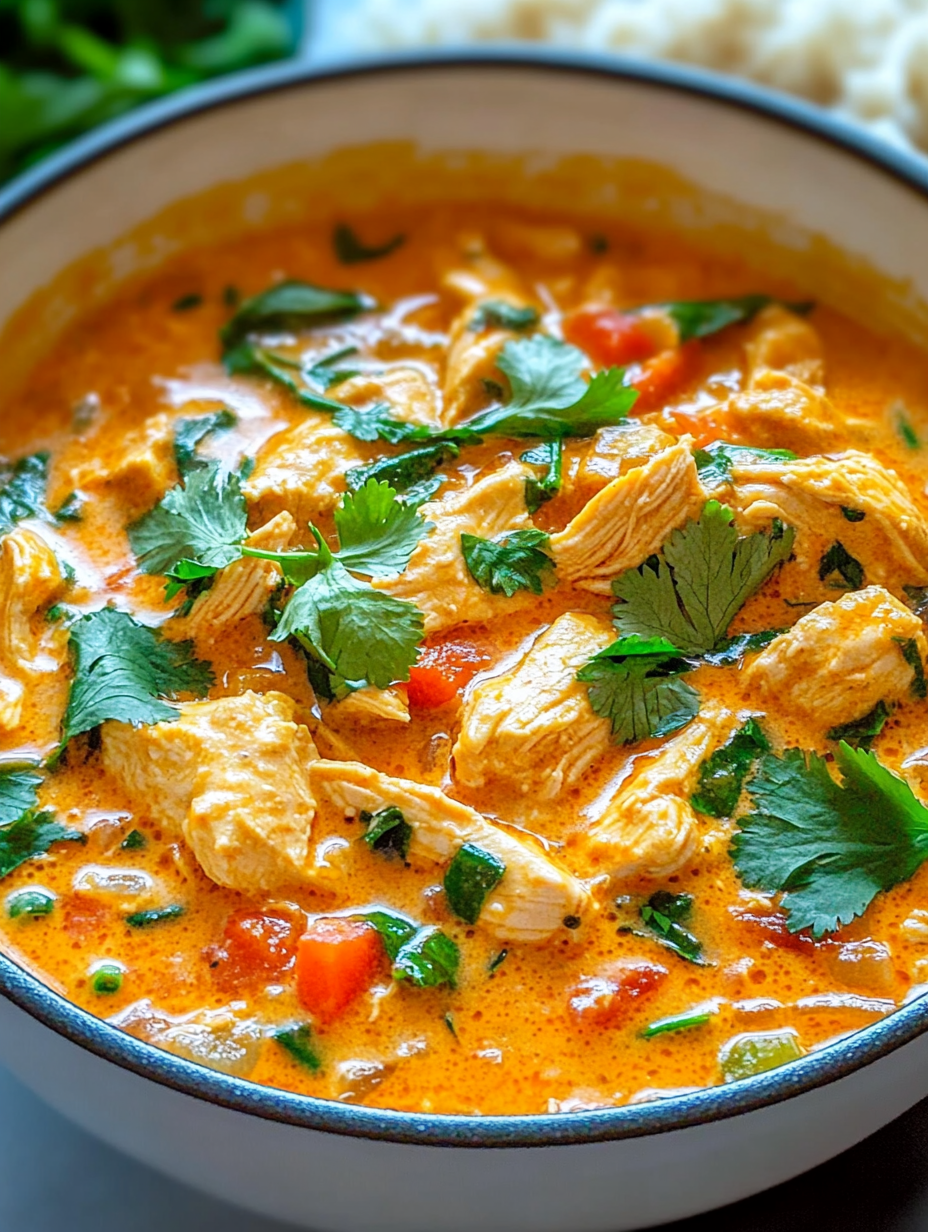Introduction
I first discovered Thai chicken coconut curry on a rainy evening when I craved something both spicy and soothing. The creamy coconut milk combined with fragrant herbs and spices instantly lifted my mood. Since then, I’ve perfected a version that’s easy enough for any weeknight but rich and flavorful enough to impress guests. This curry captures the essence of Thai cuisine—balanced, vibrant, and comforting. It’s become one of my favorite dishes to make when I want something that feels indulgent yet fresh. Whether served with jasmine rice or rice noodles, this recipe always brings warmth and satisfaction to the table.
Why You’ll Love This Recipe
Versatile
This Thai chicken coconut curry adapts well to what you have on hand. Swap vegetables freely—bell peppers, bamboo shoots, or snap peas all work beautifully. You can adjust the spice level from mild to fiery with just a tweak of chili.
Budget-Friendly
Most ingredients are pantry staples or easily found at your local market. Chicken, coconut milk, and simple spices create a dish that’s both affordable and full of flavor. No expensive pastes or sauces needed.
Ingredients for the Recipe
To make this flavorful curry for four, you’ll need:
-
Chicken breast or thighs (boneless, skinless) – Cut into bite-sized pieces.
-
Coconut milk (full-fat, 1 can – about 400 ml) – For creamy richness.
-
Turkey bacon – Adds a subtle smoky note without overpowering the curry.
-
Garlic (3 cloves, minced)
-
Fresh ginger (1 tablespoon, grated)
-
Red curry paste (2 tablespoons) – Adds authentic Thai spice and depth.
-
Fish sauce (2 tablespoons) – For umami and saltiness.
-
Brown sugar (1 tablespoon) – Balances heat and acidity.
-
Lime juice (from 1 lime) – Adds brightness and tang.
-
Onion (1 medium, sliced)
-
Bell peppers (1–2, sliced)
-
Fresh basil or cilantro – For garnish and fresh herbal aroma.
-
Salt and pepper – To taste.
How to Make This Recipe
Step-by-Step Instructions
Step 1: Prepare the Ingredients
Cut the chicken into bite-sized pieces and set aside. Slice the onion and bell peppers evenly. Mince the garlic and grate the fresh ginger. Chop the turkey bacon into small strips. Have your lime juice ready to add at the end.
Step 2: Cook the Turkey Bacon
Heat a tablespoon of oil in a large skillet or wok over medium heat. Add the chopped turkey bacon and sauté for about 3 minutes until it releases its smoky aroma and starts to crisp slightly. Remove the bacon from the pan and set it aside, leaving the flavorful fat in the skillet.
Step 3: Sauté Aromatics
In the same skillet, add the sliced onion, minced garlic, and grated ginger. Cook for 3–4 minutes, stirring often, until the onion softens and the mixture becomes fragrant. This builds the curry’s aromatic foundation.
Step 4: Add Red Curry Paste
Stir in the red curry paste and cook for another minute. This step helps release the essential oils and deepens the flavor of the paste, creating a rich base for your curry.
Step 5: Add Chicken and Coat with Curry
Add the chicken pieces to the pan. Stir well so each piece is coated with the curry paste and aromatics. Cook for about 5 minutes, stirring occasionally, until the chicken starts to brown and cook through slightly.
Step 6: Pour in Coconut Milk
Slowly add the full-fat coconut milk, stirring gently to combine. Bring the mixture to a simmer. The creamy coconut milk balances the spice and adds luscious texture.
Step 7: Add Vegetables and Simmer
Add the sliced bell peppers and cooked turkey bacon back into the pan. Let everything simmer gently for about 10 minutes. This cooks the vegetables just enough to retain their crispness and allows the flavors to meld beautifully.
Step 8: Season the Curry
Stir in the fish sauce and brown sugar. These add a perfect balance of saltiness and sweetness, enhancing the overall flavor. Adjust seasoning with salt and pepper if necessary.
Step 9: Finish with Lime Juice and Fresh Herbs
Remove the curry from heat and stir in the fresh lime juice. The acidity brightens the dish and balances the rich coconut milk. Sprinkle chopped fresh basil or cilantro over the top to add freshness and an herbal aroma.
Step 10: Serve
Serve your Thai chicken coconut curry hot over steamed jasmine rice or with rice noodles. The creamy, spicy sauce pairs perfectly with fluffy rice, soaking up every delicious bite.
Quick and Easy
This curry comes together in under 40 minutes, making it ideal for a flavorful weeknight meal. Most of the cooking happens in one pan, reducing cleanup time. The layering of flavors happens naturally as you cook step-by-step, with no complicated techniques involved.
Customizable
Feel free to switch up the vegetables—snap peas, zucchini, or baby corn all work well. If you prefer more heat, add extra red curry paste or fresh sliced chilies. For a lighter version, use light coconut milk or reduce the amount slightly. You can also swap turkey bacon with chicken ham for a different smoky note or omit it entirely for a vegetarian-friendly version.
Perfect for Guests
This dish impresses with its vibrant color and intoxicating aroma. The balance of spicy, sweet, and tangy flavors always draws compliments. Prepare the ingredients ahead to make the cooking process quick and smooth when entertaining. Pair it with simple sides like cucumber salad or fresh spring rolls for a complete Thai-inspired meal.
FAQs (Frequently Asked Questions)
Can I use chicken thighs instead of chicken breast?
Yes, boneless, skinless chicken thighs work wonderfully. They stay juicy and tender, even after simmering in the curry sauce.
What if I don’t have red curry paste?
You can substitute with Thai green curry paste or yellow curry paste for a slightly different flavor profile. If you don’t have any, mix ground coriander, cumin, turmeric, and chili powder to approximate the taste.
Can I make this curry vegetarian?
Absolutely. Replace chicken with tofu or mixed vegetables like mushrooms, eggplant, and zucchini. Omit the turkey bacon or use a plant-based alternative.
Is fish sauce necessary?
Fish sauce adds umami and depth. If you prefer, substitute with soy sauce or tamari for a vegetarian option.
Can I prepare this dish ahead of time?
Yes, the flavors develop even more after resting. Store in an airtight container in the fridge for up to 2 days. Reheat gently on the stovetop.
How spicy is this curry?
It’s moderately spicy. You can adjust the heat by adding more or less red curry paste or skipping the chili flakes.

